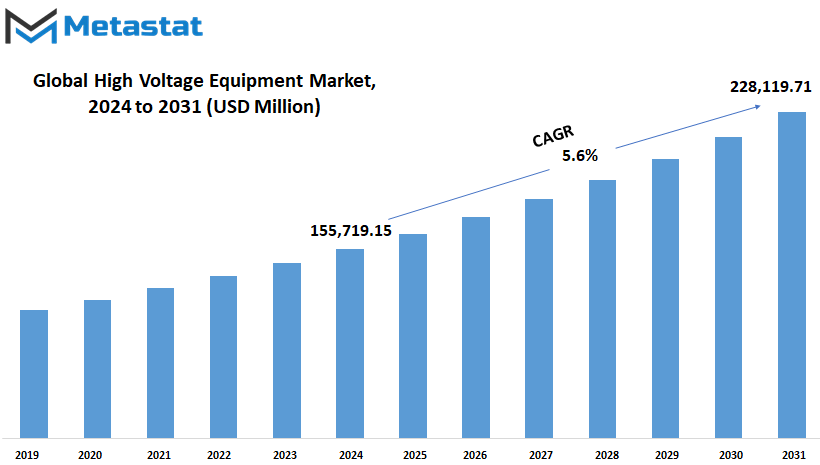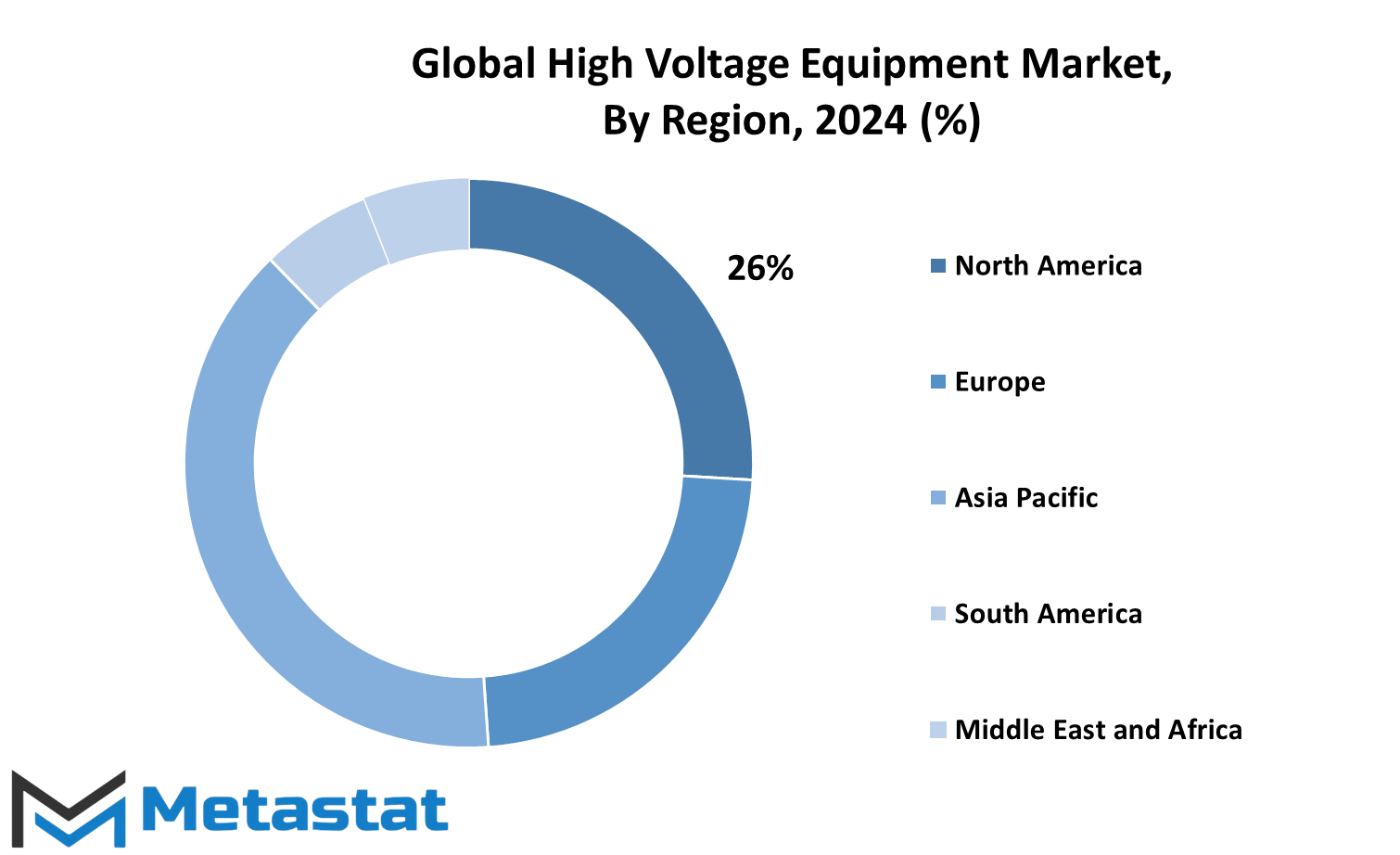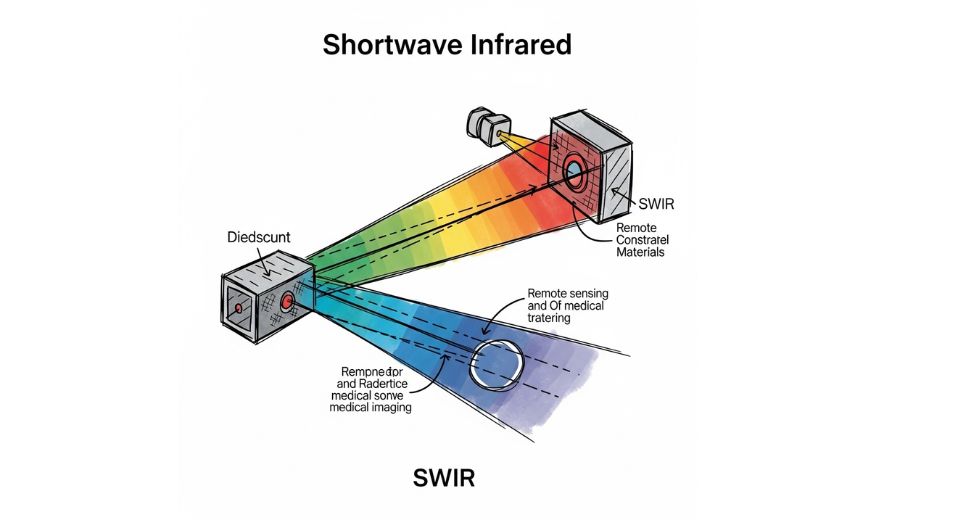MARKET OVERVIEW
The Global High Voltage Equipment market represents a specialized sector of the electrical and energy industries, comprising the most advanced technologies and systems devised to manage, transmit, and distribute electricity efficiently and safely. The market services power utilities, industrial sectors, and infrastructure projects with a demand for reliable energy transmission over long distances and in challenging environments. Its significance lies in ensuring uninterrupted electricity supply, addressing energy demands, and supporting modernization efforts in power grids worldwide.
This market is focused on equipment that operates above 1000 volts, including transformers, circuit breakers, insulators, capacitors, and switchgear. These are the building blocks of high-voltage networks, allowing electricity to be transferred from generation facilities to end consumers with minimal energy losses. The increasing complexity of global energy systems, coupled with the rising demand for electricity, will drive advancements in this field, making it indispensable for modern economies.
The Global High Voltage Equipment market spans across wide applications across the domains of renewable energy, industrial automation, and transportation. This will act as an enabling tool to introduce solar and wind power as an essential component in the national grid. In efforts made to achieve sustainability, along with carbon emissions, it would be through high voltage equipment that adoption in their infrastructure will take place and raise the level of grid efficiency.
Geographically, the market extends to developed regions with established power infrastructures and emerging economies undergoing rapid electrification. Developed countries will upgrade and modernize aging grid systems, whereas emerging markets will expand their transmission and distribution networks. Both contexts will drive demand for innovative solutions in the high-voltage sector.
Technological advancements will be the defining feature of this market’s evolution. Smart grids, digital monitoring systems, and advanced insulation materials will form the future of high-voltage equipment. These will increase operational efficiency, reduce downtime, and ensure strict safety standards are met. Moreover, high-voltage direct current (HVDC) systems for long-distance transmission will create new opportunities for manufacturers and service providers while setting the benchmark for energy efficiency.
Additionally, governmental regulatory frameworks and environmental needs have bearing on the dynamics of the global high voltage equipment market. The governments and international body will enforce standards to attain safety, reliability, as well as environmental compliance standards. This will drive their investment in research and developments toward the emergence of “green” and sustainable, eco-friendly high-voltage solutions.
In the coming years, the Global High Voltage Equipment market will experience greater collaboration between the industry players, research institutions, and policymakers to challenge problems and capitalize on opportunities. Growing dependence on renewable energy, the need for resilient infrastructure, and innovation in electrification technologies will determine this market’s path. Being an integral part of the global energy landscape, this market will continue to influence the future of energy systems in terms of economic development and sustainable growth.
Global High Voltage Equipment market is estimated to reach $228,119.71 Million by 2031; growing at a CAGR of 5.6% from 2024 to 2031.

GROWTH FACTORS
The Global High Voltage Equipment market is likely to undergo tremendous changes in the face of the growing energy requirements and needs of the world. One of the most significant factors that propel this market is the increased electricity demand in developing economies. With nations working to upgrade their infrastructure and spur urbanization, the requirement for robust and efficient energy distribution systems becomes a crucial issue. High voltage equipment ensures that there will be an efficient transfer of power across distances with no energy wastage.
This supports economical development as well. Since demand has been increasing tremendously, huge opportunities are facing the manufacturing and investing classes. Increased investment in the infrastructure for renewable energy drives this market forward. Governments and private organizations around the world are focusing on cleaner, renewable sources of energy to address environmental issues and combat climate change. Solar, wind, and hydropower projects require advanced high voltage equipment for efficient energy integration into the grid.
These investments are expected to spur innovation and improve the adoption of cutting-edge solutions that meet the specific needs of renewable energy systems. Despite the optimistic outlook, certain challenges could hinder the progress of the market. Regulatory barriers and environmental concerns remain prominent issues.
The installation and operation of high voltage equipment are subject to stringent regulations to ensure safety and environmental compliance, which may slow project execution. Additionally, the high initial costs associated with these systems could deter some stakeholders, particularly in regions with limited financial resources. However, these challenges will not be insurmountable as technological advancements continue to define the industry landscape.
Development of smart grid solutions would most likely provide opportunities in size for the market during coming years. Enhanced efficiency along with real-time monitoring along with better load management smart grids rely much upon sophisticate high voltage equipment and would revolutionize ways and manners of how powers shall be transmitted as well as distributed to further this approach to a sustainable reliable form of energy system.
Looking ahead, the Global High Voltage Equipment market stands to benefit from innovation and policy support, as well as increasing energy demands. Through addressing existing challenges and exploiting technological advancements, this market is well-positioned to support global energy transitions and meet future power requirements. The focus on renewable energy and smart grids puts underlined the importance that will be placed on the future of this market for building a sustainable energy future.
MARKET SEGMENTATION
By Type
A highly growing market for global High Voltage Equipment is observed with the need to upgrade aging electrical infrastructure and rapidly increasing demand for reliable power supply. This market, categorized along type lines, includes power transformers, switchgear, switches, battery sets, reactive power devices, and other related items such as instrument transformers, relay panels, earthing equipment as classified in various parts of the world and holds keys to shaping future energy systems. The rising interest in the integration of renewable energy sources and the growth of smart grid technologies are factors that create an optimistic scenario for the adoption of high-voltage equipment.
Power transformers are still important for efficient electricity transmission over long distances, reducing energy losses, and ensuring the stability of the grid. Energy demand is increasing all over the world, and strong, high-capacity transformers are needed. Switchgear systems and switches are used for the protection of electrical networks. Such products are in constant demand because of the importance their function holds for the proper supply of power without disruption and safety in industrial, commercial, and residential areas.
The use of battery sets is increasingly more prevalent in renewable energy sources. Energy storage systems become very crucial in ensuring reliability of the grid and consistent usage of solar and wind power. Besides, there are reactive power devices, as well as instrument transformers, which are essential to the maintenance of voltage stability and accurate measurement, making the system operational with minimum inefficiency in complex electrical systems.
Relay panels and earthing equipment play a significant role in securing a system through protection from electrical faults, hence augmenting system safety. Technology development of reliable and efficient solutions, this is yet to see further growth with traditional as well as in modern grids, while demand for high value products grows due to higher sustainability as well as the quest for energy efficiency in this marketplace.
The Global High Voltage Equipment market will even go further in the coming years, since the government targets upgrading the power infrastructure to incorporate renewable energy resources. Emerging markets will, with high investments, tap into high-voltage technology due to a demand in accessing electricity and industrializing their economies. In addition, advancements in materials as well as digital technologies shall develop smarter and more effective solutions for high voltage power delivery, paving the path towards a stronger and even more sustainable power network.
The Global High Voltage Equipment market has enormous growth potential, which will be driven by the demands of changing energy requirements, technological advancements, and global transitions towards cleaner energy solutions. Each segment in this market contributes to building a future-ready power landscape with efficiency, reliability, and sustainability.
By Voltage Level
The global high voltage equipment market plays a very critical role in meeting the growing needs of energy for the world. With expanding industries and technological advancements, the power transmission systems continue to grow at increasing rates. High voltage equipment will be needed for the power transmission over long distances. This is crucial for little or no energy loss and further helping the infrastructure of developing as well as developed regions. With the shift towards sustainable energy solutions, the market for such equipment is set to grow even further in the coming years.
One of the ways through which the market is classified is by voltage levels, addressing different energy requirements. The HV-Up to 200kV Voltage segment is primarily used in regional power distribution and is usually utilized for urban areas and small-scale industries. Its relatively lower cost and efficiency in managing moderate power loads make it a widely used choice in many countries. As cities grow and the need for localized power distribution increases, this segment will continue to remain significant.
On the other hand, the EHV-200 to 800kV Voltage segment caters to the larger transmission networks; most often, it is utilized in inter-city or inter-state power grids. It’s essential to ensure that this level delivers power over medium and long distances without significant losses. With increasing urbanization and industrialization around the world, especially in developing countries, this segment is likely to continue to grow steadily. This category also facilitates renewable energy sources such as wind and solar farms to become a part of the power grid.
In view of such capabilities, the HVDC-500kV Voltage level is gaining much popularity for the transmission of electricity across long distances and is under widespread use as countries invest more and more in cross-border power projects. This technology is even more important to connect the renewable energy projects in far off locations to urban demand centres. Adoption of HVDC Systems manifests the strong push towards power grid modernization to increase load handling capacities and mixed energy sources.
The UHV-800kV & Above tops the chain as the technological advancements at the top, in this case, meant for the ultra-high voltage necessities, commonly used for long distance transmission of electricity in vast terrains and high energy requiring areas. As technology moves forward, such equipment will gradually be deployed more, especially within countries investing in large-scale projects.
The Global High Voltage Equipment market is on the way to growth because the world continues to emphasize reliable, sustainable, and efficient energy solutions. Each voltage level offers distinct benefits, so the market will remain diverse and adaptable to the energy needs of the future.
By Application
The Global High Voltage Equipment market is a critical part of the modern energy sector, playing a key role in supporting the increasing demand for electricity around the world. This market is highly driven by technological developments and the growing need for efficient power systems to support the expansion of populations and industries. It ensures that there is a stable and reliable supply of electricity throughout regions by addressing the challenges of energy transmission and distribution.
Power transmission is one of the major applications of high voltage equipment. The recent shift towards renewable sources like wind and solar power, has increased the need for long-distance power transmission. The sources are mostly sited far from the location of high energy consumption areas and thus require advanced equipment for the transmission of electricity over long distances without losing a significant amount of power. Innovations in the field focus on enhancing energy efficiency and minimizing environmental impact to make power transmission the very backbone of future energy solutions.
High voltage equipment finds another very crucial application in the power distribution sector. As cities continue to mushroom, so does the emergence of new residential and industrial areas that create an enormous demand for a reliable network for electricity supply. It ensures the safe and efficient delivery of electricity to consumers. This includes equipment such as transformers, switchgear, and circuit breakers that manage voltage levels and protect systems from overloads. Governments and the private sector are investing highly in modernizing distribution networks to cater to the needs of communities and industries that are changing, thus making sure there is consistent access to energy.
The Global High Voltage Equipment market’s future looks bright with the rapid industrialization and transition towards cleaner sources of energy. Smart grids and digital technologies will highly contribute to the growth of this market. Such technologies allow for the better monitoring and management of energy systems. This results in greater efficiency and lower downtime. Integrating high voltage equipment into renewable energy systems will increasingly be required in order for countries to achieve lower levels of carbon emissions.
This high voltage equipment market is crucial for the world’s energy sector because both power transmission and distribution use it. Moving into this sustainable energy future will increasingly require innovative solutions for demand in this market. Issues of energy efficiency and reliability will be an impetus for the future for equipment in high voltages and will continue to shape this global energy landscape.
|
Forecast Period |
2024-2031 |
|
Market Size in 2024 |
$155,719.15 million |
|
Market Size by 2031 |
$228,119.71 Million |
|
Growth Rate from 2024 to 2031 |
5.6% |
|
Base Year |
2022 |
|
Regions Covered |
North America, Europe, Asia-Pacific Green, South America, Middle East & Africa |
REGIONAL ANALYSIS
The Global High Voltage Equipment market is witnessing a stable growth pace mainly due to the demand of reliable power infrastructure in widely spread geographic locations. Market segmented on the basis of geography reveals that different trends are noticed based on economies, technology, and requirements of energy sources in the locations. North America comprises countries such as the United States, Canada, and Mexico, which have already been growing due to their already existing power networks and increased emphasis on upgradation of old infrastructure. The U.S. contributes significantly to this growth curve because of its advanced technologies and investment in renewable energy integration. Similarly, Canada and Mexico are contributing through efforts towards modernizing their electrical grids and rising power requirements.
Europe is another main area in the Global High Voltage Equipment market. Innovations and practices in 'going green' are fueled by the UK, Germany, France, and Italy, among many other nations in this area. The commitment towards reducing carbon emissions in this region has driven investments into renewable energy projects, that also call for efficient high-voltage equipment. For example, Germany is putting emphasis on greener energy sources, while the UK is exploring advancements in grid technologies. These efforts around Europe are adding to a steady growth of the market, as collaborations between the government and private sectors continue to gain momentum.
Asia-Pacific is an emerging region for the Global High Voltage Equipment market, mainly due to rapid industrialization and urbanization in nations like India, China, Japan, and South Korea. The demand for stable and scalable power infrastructure in this region is enormous, driven by population growth and increasing energy consumption. China and India are making significant investments in smart grids and transmission systems to support their economic growth. Japan and South Korea focus on introducing advanced technologies in order to improve the efficiency of power distribution.
In South America, Brazil and Argentina are the dominant market players. Their developing industries have boosted the demand for efficient energy transmission. In the region, investments in renewable energy projects enhance the requirement for high-performance equipment. Finally, the Middle East & Africa holds much promise as the GCC nations, Egypt, and South Africa diversify energy consumption. With urban expansion, there is an increased necessity for electricity in these geographies. Hence, high-voltage solutions that have the required superior features would be selected by these geographies.
Technological advancements, policies, and the growing emphasis on sustainable energy solutions across the world are in place to drive the worldwide high voltage equipment market steadily across regions.

COMPETITIVE PLAYERS
The Global High Voltage Equipment market is determining the future of energy systems around the world, due to technological innovation, the rising demand for electricity, and the shift towards sustainable energy sources. The market offers a broad range of products that are critical in the transmission and distribution of electrical energy over long distances. High-voltage equipment has been a part of power grids, and it has only become more so as countries continue to expand their infrastructure to meet growing populations and industries. As the years go by, this market is liable to undergo tremendous change catalyzed by such emerging technologies as well as changing energy demands.
The key players in this industry are ABB Ltd., Siemens AG, General Electric Company, Rockwell Automation, Inc., Eaton Corporation, Mitsubishi Electric Corporation, Toshiba Corporation, Hitachi Ltd., Fuji Electric Co., Ltd., Alstom SA, CG Power & Industrial Solutions Ltd., Bharat Heavy Electricals Limited (BHEL), Hyosung Corporation, R&S GmbH, Hyundai Electric & Energy Systems Co., Ltd., Nissin Electric Co., Ltd., and Meidensha Corporation. These companies are researching and developing advance products that will boost the grid performance, cut energy loss, and conform to the environmental standards.
Future Global High Voltage Equipment market development would be greatly influenced by smart grid technology as well as the integration of renewable energy sources. Both governments and the private sector are investing greatly in electrical infrastructure modernization for strength against climate change-related challenges. For example, energy storage systems in conjunction with high voltage equipment will be critical in balancing supply and demand as solar and wind power becomes more prevalent. This change requires not only advanced technology but also cooperation among key players to set global standards and streamline operations.
Competing players are now seeking to expand their geographical presence and customer solutions for the particular needs of different regions. There is a growing interest in high voltage equipment in developing economies with each passing day by supporting electricity consumption. The developed nations, on the other hand, focus on grid upgrades and environmental compliance. Material innovations such as lightweight and more durable components will also be shaping the future map of the market.
With evolving industrial processes through automation and digitalization, high voltage equipment is expected to add smarter functionalities into monitoring and maintenance. The market is open for continued growth as players look to outcompete each other in providing state-of-the-art solutions. These efforts will ensure that the Global High Voltage Equipment market becomes the corner of the global energy infrastructure empowering nations to meet the challenges of tomorrow.
High Voltage Equipment Market Key Segments:
By Type
- Power Transformers
- Switchgear
- Switches
- Battery Set
- Reactive
- Power Instrument Transformer
- Relay Panel
- Earthing Equipment
- Other
By Voltage Level
- HV-Up to 200kV Voltage
- EHV-200 to 800kV Voltage
- HVDC-500kV Voltage
- UHV-800kV & Above
By Application
- Power Transmission
- Power Distribution
Key Global High Voltage Equipment Industry Players
- ABB Ltd.
- Siemens AG
- General Electric Company
- Rockwell Automation, Inc.
- Eaton Corporation
- Mitsubishi Electric Corporation
- Toshiba Corporation
- Hitachi Ltd.
- Fuji Electric Co., Ltd.
- Alstom SA
- CG Power & Industrial Solutions Ltd
- Bharat Heavy Electricals Limited (BHEL)
- Hyosung Corporation
- R&S GmbH
- Hyundai Electric & Energy Systems Co., Ltd.
- Nissin Electric Co., Ltd.
- Meidensha Corporation
WHAT REPORT PROVIDES
- Full in-depth analysis of the parent Industry
- Important changes in market and its dynamics
- Segmentation details of the market
- Former, on-going, and projected market analysis in terms of volume and value
- Assessment of niche industry developments
- Market share analysis
- Key strategies of major players
- Emerging segments and regional growth potential







 US: +1 3023308252
US: +1 3023308252






